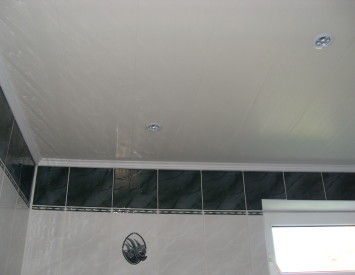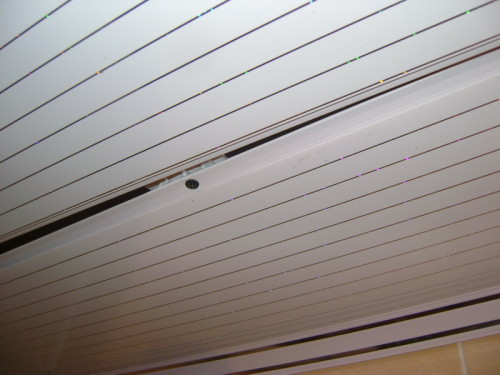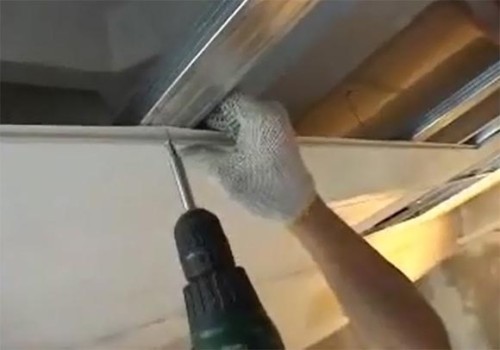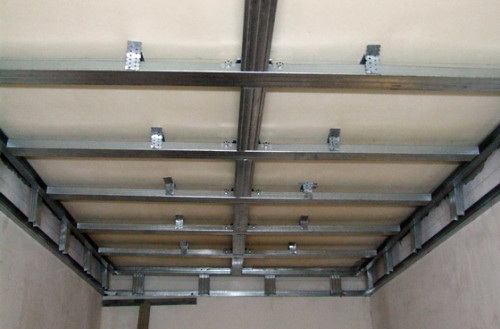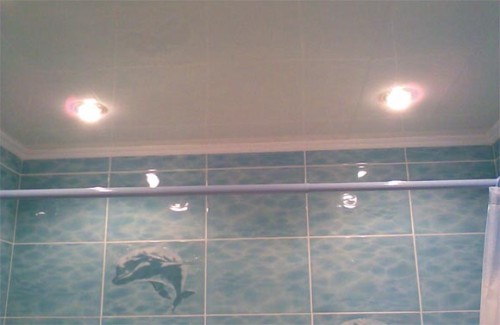A hung ceiling made of plastic for the bathroom is the best option when decorating this room. The speed of installation and the low cost of materials make it the most popular type of finish. Compared to other PVC materials, the panels are not afraid of moisture, which is very important for the bathroom, they are easily washed and retain their original appearance for a long time. Currently, manufacturers of plastic panels offer products for every taste - from simple monophonic panels of minimum width, to wide with interesting drawings. The installation of a suspended ceiling will hide all the communications that are in the room (wiring, ducts from hoods or water supply pipe). Due to the fact that the plastic ceiling does not pass steam and moisture, it will be possible not to worry about the condition of the primary ceiling. From the variety of textures and drawings on plastic panels, you can choose what is suitable for the design of your bathroom.
Content
- Types of plastic profiles for installing a plastic ceiling in the bathroom
- Selection of materials
- Installing plastic ceiling with your own hands. Preparation for installation
- Installation of a label of a plastic ceiling in the bathroom
- Installation of a plastic ceiling in the bathroom
- Plastic ceiling in the bathroom: video
Unlike drywall or stretch ceiling, plastic is very easy to assemble and disassemble. The replacement of the entire ceiling coating can be easily done independently. About how to install a plastic ceiling in the bathroom with your own hands is further.
Types of plastic profiles for installing a plastic ceiling in the bathroom
For the installation of plastic panels both on the ceiling and on the wall, the following types of profiles are used:
- Starting profile. It is designed to conceal the ends of the panels. It is attached around the perimeter of the room.
- F-profile. It is necessary for a smooth transition from a wall closing plastic to a wall that does not close.
- N-profile. Designed to connect the panels and to increase their length. It is used when the height or width of the room is too large for closing with one whole panel.
- Plastic corners. They are used to close the ends of the panels in external and inner corners.
- Plastic ceiling plinth. It is used for a noble decoration of a plastic ceiling. In fact, it is no different from the starting profile.
- Universal plastic corner. It is glued to any corners, however, it has not a very beautiful appearance.
Selection of materials
For the installation of a plastic ceiling, the following materials will be necessary:
- Plastic panels. When choosing, it is necessary to pay close attention to their quality. They must be even, plain. Cheap plastic has one not quite pleasant property - it shines through the light of spotlights, spoiling the whole picture of the repair. Therefore, it is better not to cheat and buy quality material than “enjoy” the time spent in vain.
- Profile metal guide (UD). The amount of this material depends on the size of the bathroom. It will be installed around the perimeter of the room. Accordingly, its number will be equal to the sum of the lengths of all walls of the bathroom.
- Metal ceiling profile (CD). It is designed to install the ceiling crate. This profile is installed perpendicular. For reliable fixing the plastic to the ceiling and preventing its deflections, this step should not be more than 0.5 m when installing the profile. Depending on this parameter, the required amount of material can be calculated.
- Be careful when choosing profiles. It is necessary to buy only high -quality galvanized so that they are not covered with rust from high humidity in the room.
- Brackets for attaching the ceiling profile to the main floor. They are installed with a step of not more than 0.7 m. Otherwise, under the weight of the entire structure, the profile can bend. They are attached to the ceiling with dowels of fast installation.
- Self -tapping screws for fastening profiles (the so -called "seed").
- Self -tapping screws for attaching plastic panels to profiles.
- Starting plastic panel or ceiling plinth.
- The dowels of fast installation.
- Plastic panels.
From the tool you will definitely need:
- Perforator or shock drill.
- Scurgery.
- Electrician.
- Level, roulette, pencil, knife.
Installing plastic ceiling with your own hands. Preparation for installation
Before installation, it is necessary to draw up an installation circuit. It will help to correctly calculate the amount of materials and determine the sequence of work. Usually the installation of the ceiling begins with faced walls, that is, after the tile is laid on the walls of the bathroom.
To fix the guide profile, you can use two methods: fastening on the wall or fastening on the tile. The second method is most preferable because with it there is no risk of damaging the tile when drilling holes. It must be remembered that if the tiles come across, then when the hole is drilling, it can burst. When using the first method, it must be remembered that when attached to the wall above the tile nearby, the width of the guide profile decreases, which will make it impossible to fasten the starting ceiling skirting board. From this situation there is a simple way out: to “build up” the wall above the upper row of tiles using plaster. The process is not too complicated. To do this, you need plaster, a plastic spatula (it is not advisable to use metal so as not to spoil the surface of the tile), a painting tape. The upper part of the tile is sealed with them, so as not to stain the inter -seams with plaster.
First of all, tiles are glued with tape, then gently the wall is aligned with plaster under the level of tiles. Installation of the guide profile can begin after the plaster has completely dried. This is usually the next day. The profile is attached using a dowel of quick installation. If the tile is laid correctly, then it can serve as a level for installing the profile. It is attached around the entire perimeter, fixing one after another in the corners.
Installation of a label of a plastic ceiling in the bathroom
Work order:
- After the installation of the bypass profile, you can proceed to the installation of the crate. To do this, use wide CD profiles. They are started in a roundabout profile, installed perpendicular to the direction of plastic panels. Transverse profiles are attached to the bypass using small screws (seeds). They are better not to save and install 2 pcs. on one connection. When installing transverse profiles, indicate on the ceiling the place of fastening of future lamps so that the profile becomes at the required distance.
- After the crate is collected, transverse profiles using suspensions must be attached to the main ceiling overlap. If the ceiling will fall to a small height, then standard brackets should be enough. Otherwise, you need to use special suspensions.
- Such brackets are attached to the ceiling using fast installation dowels, and to the profiles with the same seed. When fastening transverse profiles, their position must be controlled by level.
On this installation of the frame is finished, you can start installing a plastic ceiling in the bathroom.
Installation of a plastic ceiling in the bathroom
Work order:
- The first step in the work of work will be the installation of a plastic starting skirting board. It is attached to the bypass profile using metal screws with a press-shame. In the corners of the room, you can cut off the baseboard under 45 ° using the stizels, however, it will be much more reliable to insert them into each other, cut them out diagonally and fix them with a self -tapping screw.
- Before starting the installation of plastic ceilings in the bathroom, be sure to connect (but in no case connect) the lighting wiring, at the ends of the wires, install the terminals. Fasten the wiring to the profiles or suspensions using plastic clamps.
- Now you can pore the panels. Before starting work, it is necessary to remove a plastic film from the panels. This is a very common mistake, especially among those who do this for the first time.
- Cut the panel a little shorter than the width of the room is approximately 4-5 mm. The panel must be cut either with a jigsaw with fine tiles or a hacksaw for metal, with a mandatory processing of the cut place with a small skin.
- When the panel is ready, they begin installation. The first to start a narrow end in the profile. Then the panel bends slightly and starts wide.
- To slightly spread the profile for the panel, you can use a spatula, only you need to do this carefully so as not to spoil the plastic.
- After the panel is inserted into the profile in front and from the sides, its back is screwed with self -tapping screws to the transverse profiles. Now the role of the starting, in which the subsequent panel will be inserted, will play the previous one.
- Next, we move according to the specified scheme. In the place where the installation of lamps is planned, in the panel it is necessary to make slots. They are made with a special crown or a simple knife. It is more convenient to carry out this work before installing the panel than to do it “in place”.
- The greatest difficulty in installing a plastic ceiling is the installation of the last panel. Naturally, if the length of the room is not multiple of the size of the panel, it will need to be cut along. You can do this with a knife. The width of the last panel should be slightly smaller than the distance from the penultimate to stop the ceiling starting baseboard.
- First, we start the last panel into the skirting board, and then with the help of ordinary adhesive tape glued to its surface, we serve it towards the penultimate and snap the lock.
- That's all, now it remains to install lamps and a plastic rack ceiling for the bathroom is ready.
